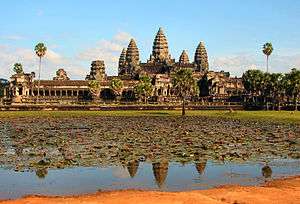Khmer Empire
Understand
The empire was centered in Cambodia and ruled much of modern-day Thailand, Laos, Vietnam and Myanmar for over 600 years.
The cultural underpinnings of the Khmer began in the first century when the Kingdom of Funan emerged, one of the first Indian-influenced states of Southeast Asia. This was followed by Chenla, which may have been a kingdom or a loose confederation of small states, in the seventh and eighth centuries. In 802, King Jayavarman II stood atop the sacred Phnom Kulen mountain, declared Cambodia's independence from Java and founded the Khmer Empire.
The Khmer were experts at building vast irrigation systems, large reservoirs called baray, sophisticated road networks and most notably, enormous temples and religious monuments. The empire accumulated its wealth as it became immersed in the maritime Silk Road trade routes, connecting the Khmers to India, China, Arabia and even parts of Europe.
Destinations

Cambodia
- 🌍 Angkor Wat. Undoubtedly the most famous and grandest Khmer archeological site spanning more than 400 km2 (150 sq mi) and protected as a UNESCO World Heritage site since 1992.
- 🌍 Banteay Chhmar. Despite, Banteay Chhmar having one of the biggest temples in Cambodia, it is among the least understood.
- 🌍 Koh Ker.
- 🌍 Phnom Kulen National Park. The Phnom Kulen mountain was the place where King Jayavarman declared the formation of the Khmer Empire. The park also contains many beautiful Angkorian rock-relief sculptures.
- 🌍 Preah Vihear. The Preah Vihear temple atop of the mountain cliff provides stunning views of the surroundings, including the Thai-Cambodian border. The temple is part of the broader Thai and Cambodian disputed territory. Most of the time, it is relatively safe to go but note that at any time geopolitical tensions between the Southeast Asian neighbors can flare up again.
- 🌍 Sambor Prei Kuk. A pre-Angkorian Chenla site, this temple built in the 7th century is simpler than the ones that followed but still possesses a remarkable beauty.
Thailand
- 🌍 Mueang Sing Historical Park (Prasat Muang Sing). The military outpost and small temple complex built by King Jayavarman VII here for a period represented the westernmost extent of the empire. The main temple has four entrances and has been partially rebuilt after archeologists excavated it in the 1970s.
- 🌍 Phanom Rung Historical Park (close to Nang Rong). The temple at Phanom Rung has been restored to almost its original conditions by the Thai government. One of the most impressive parts of the temple is the meticulously decorated lintel, which for two decades was in the hands of the Art Institute of Chicago, but has now rightfully been brought part and is part of the temple once more.
- 🌍 Phimai. One of the best-preserved Angkorian sites in Thailand. Phimai was at the western end of the "Angkorian highway", the road connecting Angkor with many other Khmer cities and towns. The temple is somewhat unusual in being originally built as a Buddhist temple as the inhabitants in the 7th century were already Buddhist.
- 🌍 Surin.
Vietnam
- 🌍 My Son. My Son was a major city in the Champa Kingdom, the eastern neighbors and fierce rivals to the Khmer. My Son was raided and pillaged many time by Khmer kings during their ongoing battles with the Champa. While the architecture of the temple complexes is characteristically Champa, there are clear Khmer influences as well.
Stay safe
Some of the lesser-known Khmer sites are in the middle of the jungle, which is still full of landmines, a result of the three decades of war that Cambodia and neighboring Indochinese countries endured during the Cold War.